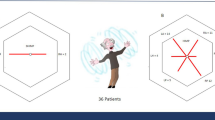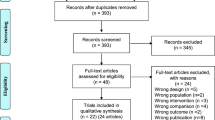Abstract
Prism adaptation (PA) affects visuospatial attention such as spatial orienting in both the right and left hemifields; however, the systematic after-effects of PA on visuospatial attention remain unclear. Visuospatial attention can be affected by non-spatial attentional factors, and postural control difficulty, which delays the reaction time (RT) to external stimulation, may be one such factor. Therefore, we aimed to investigate the influence of postural control difficulty on changes in spatial orienting of attention after leftward PA. Seventeen healthy young adults underwent 15-min and 5-min PA procedures for a leftward visual shift (30 diopters). Participants underwent the Posner cueing test immediately before (pre-evaluation) and in between and after the PA procedures (post-evaluations) while standing barefoot on the floor (normal standing condition) and on a balance-disc (balance standing condition). In the pre-evaluation, RTs in the balance standing condition were significantly longer compared to those in the normal standing condition for targets appearing in both the right and left hemifields. Leftward PA improved the RT for targets appearing in the right, but no left, hemifield in the balance standing condition, such that RTs for targets in the right hemifield in the post-evaluation were not significantly different between the two standing conditions. However, leftward PA did not significantly change RTs for targets in both hemifields in the normal standing condition. Therefore, postural control difficulty may enhance sensitivity to the features of the visuospatial cognitive after-effects of leftward PA.




Similar content being viewed by others
Data availability
Data in this study will be made available upon reasonable request to the corresponding author.
References
Andres M, Geers L, Marnette S, Coyette F, Bonato M, Priftis K, Masson N (2019) Increased cognitive load reveals unilateral neglect and altitudinal extinction in chronic stroke. J Int Neuropsychol Soc 25:644–653
Azouvi P (2017) The ecological assessment of unilateral neglect. Ann Phys Rehabil Med 60:186–190
Bakkum A, Donelan JM, Marigold DS (2020) Challenging balance during sensorimotor adaptation increases generalization. J Neurophysiol 123:1342–1354
Bonato M (2012) Neglect and extinction depend greatly on task demands: a review. Front Hum Neurosci 6:195
Bosma MS, Nijboer TCW, Caljouw MAA, Achterberg WP (2020) Impact of visuospatial neglect post-stroke on daily activities, participation and informal caregiver burden: a systematic review. Ann Phys Rehabil Med 63:344–358
Boukrina O, Chen P (2021) Neural mechanisms of prism adaptation in healthy adults and individuals with spatial neglect after unilateral stroke: a review of fMRI studies. Brain Sci 11
Brighina F, Bisiach E, Piazza A, Oliveri M, La Bua V, Daniele O, Fierro B (2002) Perceptual and response bias in visuospatial neglect due to frontal and parietal repetitive transcranial magnetic stimulation in normal subjects. NeuroReport 13:2571–2575
Chica AB, Bartolomeo P, Lupianez J (2013) Two cognitive and neural systems for endogenous and exogenous spatial attention. Behav Brain Res 237:107–123
Crottaz-Herbette S, Fornari E, Tissieres I, Clarke S (2017) A brief exposure to Leftward Prismatic Adaptation enhances the representation of the Ipsilateral, Right Visual Field in the right Inferior Parietal Lobule. eNeuro 4
Di Monaco M, Schintu S, Dotta M, Barba S, Tappero R, Gindri P (2011) Severity of unilateral spatial neglect is an independent predictor of functional outcome after acute inpatient rehabilitation in individuals with right hemispheric stroke. Arch Phys Med Rehabil 92:1250–1256
Fierro B, Brighina F, Oliveri M, Piazza A, La Bua V, Buffa D, Bisiach E (2000) Contralateral neglect induced by right posterior parietal rTMS in healthy subjects. NeuroReport 11:1519–1521
Giglia G, Mattaliano P, Puma A, Rizzo S, Fierro B, Brighina F (2011) Neglect-like effects induced by tDCS modulation of posterior parietal cortices in healthy subjects. Brain Stimul 4:294–299
Heilman KM, Valenstein E, Watson RT (2000) Neglect and related disorders. Semin Neurol 20:463–470
Husain M (2019) Visual attention: what inattention reveals about the brain. Curr Biol 29:R262–R264
Katz N, Hartman-Maeir A, Ring H, Soroker N (1999) Functional disability and rehabilitation outcome in right hemisphere damaged patients with and without unilateral spatial neglect. Arch Phys Med Rehabil 80:379–384
Kitatani R, Honda K, Inukai Y, Otsuru N, Onishi H (2023) Prism adaptation during balance standing enhances the transfer after-effect on standing postural displacement. Neurosci Lett 814:137470
Koyama S, Tanabe S, Hirakawa Y, Sakurai H, Kanada Y (2015) Effects of walking on bilateral differences in spatial attention control: a cross-over design. Arch Physiother 5:12
Lajoie Y, Teasdale N, Bard C, Fleury M (1993) Attentional demands for static and dynamic equilibrium. Exp Brain Res 97:139–144
Mademli L, Mavridi D, Bohm S, Patikas DA, Santuz A, Arampatzis A (2021) Standing on unstable surface challenges postural control of tracking tasks and modulates neuromuscular adjustments specific to task complexity. Sci Rep 11:6122
McIlroy WE, Maki BE (1997) Preferred placement of the feet during quiet stance: development of a standardized foot placement for balance testing. Clin Biomech (Bristol Avon) 12:66–70
Michel C (2006) Simulating unilateral neglect in normals: myth or reality? Restor Neurol Neurosci 24:419–430
Michel C (2015) Beyond the Sensorimotor Plasticity: Cognitive Expansion of Prism Adaptation in Healthy Individuals. Front Psychol 6:1979
Michel C, Rossetti Y, Rode G, Tilikete C (2003) After-effects of visuo-manual adaptation to prisms on body posture in normal subjects. Exp Brain Res 148:219–226
Naert L, Bonato M, Fias W (2018) Asymmetric spatial Processing under Cognitive load. Front Psychol 9:583
Nijboer T, van de Port I, Schepers V, Post M, Visser-Meily A (2013) Predicting functional outcome after stroke: the influence of neglect on basic activities in daily living. Front Hum Neurosci 7:182
Paladini RE, Wieland FAM, Naert L et al (2019) The impact of cognitive load on the spatial Deployment of Visual attention: testing the role of Interhemispheric Balance with Biparietal Transcranial Direct Current Stimulation. Front Neurosci 13:1391
Posner MI (1980) Orienting of attention. Q J Exp Psychol 32:3–25
Posner MI, Walker JA, Friedrich FJ, Rafal RD (1984) Effects of parietal injury on covert orienting of attention. J Neurosci 4:1863–1874
Priftis K, Bonato M, Zorzi M, Umilta C (2013) Spatial and non-spatial aspects of neglect. Front Hum Neurosci 7:25
Redding GM, Wallace B (1996) Adaptive spatial alignment and strategic perceptual-motor control. J Exp Psychol Hum Percept Perform 22:379–394
Robertson I, Frasca R (1992) Attentional load and visual neglect. Int J Neurosci 62:45–56
Ronga I, Sarasso P, Fossataro C, Salatino A, Garbarini F, Ricci R, Neppi-Modona M (2018) Everything is illuminated: prismatic adaptation lowers visual detection threshold in normal subjects. J Exp Psychol Hum Percept Perform 44:1619–1628
Russell C, Malhotra P, Husain M (2004) Attention modulates the visual field in healthy observers and parietal patients. NeuroReport 15:2189–2193
Schintu S, Pisella L, Jacobs S, Salemme R, Reilly KT, Farne A (2014) Prism adaptation in the healthy brain: the shift in line bisection judgments is long lasting and fluctuates. Neuropsychologia 53:165–170
Schintu S, Cunningham CA, Freedberg M, Taylor P, Gotts SJ, Shomstein S, Wassermann EM (2021) Callosal anisotropy predicts attentional network changes after parietal inhibitory stimulation. NeuroImage 226:117559
Schintu S, Kravitz DJ, Silson EH, Cunningham CA, Wassermann EM, Shomstein S (2023) Dynamic changes in spatial representation within the posterior parietal cortex in response to visuomotor adaptation. Cereb Cortex 33:3651–3663
Striemer C, Sablatnig J, Danckert J (2006) Differential influences of prism adaptation on reflexive and voluntary covert attention. J Int Neuropsychol Soc 12:337–349
Tahayori B, Port NL, Koceja DM (2012) The inflow of sensory information for the control of standing is graded and bidirectional. Exp Brain Res 218:111–118
Thut G, Nietzel A, Pascual-Leone A (2005) Dorsal posterior parietal rTMS affects voluntary orienting of visuospatial attention. Cereb Cortex 15:628–638
Tsujimoto K, Nishida D, Tahara M, Liu M, Tsuji T, Mizuno K (2022) Neural correlates of spatial attention bias: changes in functional connectivity in attention networks associated with tDCS. Neuropsychologia 177:108417
Acknowledgements
We would like to thank Editage (www.editage.jp) for English language editing. We thank the participants who volunteered in this study.
Funding
This study was partially supported by a Grant-in-Aid for Early-Career Scientists (21K17455) from the Japan Society for the Promotion of Science.
Author information
Authors and Affiliations
Contributions
All authors have made significant contributions to this article. Specifically, RK, NO, SS, and HO contributed to the research design and manuscript writing, and RK and NO contributed to data collection and analysis. All authors approved the final version of the manuscript.
Corresponding author
Ethics declarations
Consent for publication
The participants provided written informed consent for the use and publication of the data obtained in the experiments.
Conflict of interest
The authors declare that they have no conflicts of interest.
Ethical approval
All procedures performed in this study were in accordance with the ethical standards of the institutional and/or national research committee and with the 1964 Declaration of Helsinki and its later amendments or comparable ethical standards. This study procedure was approved by the Ethics Committee of Niigata University of Health and Welfare (Approval No. 18748–211007).
Consent to participate
Informed consent was obtained from all individual participants included in this study.
Additional information
Communicated by Bill J Yates.
Publisher’s Note
Springer Nature remains neutral with regard to jurisdictional claims in published maps and institutional affiliations.
Electronic supplementary material
Below is the link to the electronic supplementary material.
Rights and permissions
Springer Nature or its licensor (e.g. a society or other partner) holds exclusive rights to this article under a publishing agreement with the author(s) or other rightsholder(s); author self-archiving of the accepted manuscript version of this article is solely governed by the terms of such publishing agreement and applicable law.
About this article
Cite this article
Kitatani, R., Otsuru, N., Shibata, S. et al. Influence of postural control difficulty on changes in spatial orienting of attention after leftward prism adaptation. Exp Brain Res (2024). https://doi.org/10.1007/s00221-024-06843-6
Received:
Accepted:
Published:
DOI: https://doi.org/10.1007/s00221-024-06843-6




